The image of a modern successful person includes many details. One of them is the ability to stay in society and follow the rules of behavior at the table. Thus, you will prove yourself as a well-mannered and intelligent person.
What it is?
The history of ethics is very long. Some other cavemen knew how to behave beautifully and tried to teach others this. Label standards were formed over time and improved every time. Now this science teaches us the correct behavior at the table.

Small details are immediately evident and can spoil the first impression of a person, so it’s worthwhile to refresh the well-known etiquette rules or learn new ones. Experts recommend that children be taught the skills to handle cutlery and set the table from an early age, especially since modern manufacturers offer a wide selection of safe, bright and beautiful forks and spoons. It is believed that this skill should be practiced not only at a guest or restaurant, but also at home.

Ethics should be present at every meal. So you better understand its basics, norms and regulations.
Consider the basic rules that apply to table setting and cultural behavior at the table.
How to behave at the table?
Eating is one of those basic processes that inevitably accompany people throughout their lives. During business lunches, partners come to an agreement and sign important contracts. No festive event is complete without a buffet or a grand feast. At the table, the family feels the strongest unity, since you can discuss all the problems and enjoy the successes of the household behind a plate of food. Joint lunches or dinners bring people together and improve the quality of communication.



It is much more pleasant to deal with a person who follows the rules of etiquette, does not cause inconvenience to others, eats silently and accurately. It’s never too late to correct mistakes in your behavior and become a more cultured person.
Rules of behavior
Let us consider in more detail the features of cultural behavior during a meal.
First of all, you should pay attention to the manner of sitting on a chair. Posture of a person speaks not only about the ability to keep oneself in society, but also about habits and character. A confident person always sits with a straight back and occupies most of the seating area, his pose is laid-back and relaxed. It is this position of the body that is most appropriate at the table.

When located at the table, the brushes are placed on the edge of the table, and the elbows are slightly pressed against the body. A slight forward bend is allowed for ease of eating.

There is a little trick to learning how to sit properly at a table. To do this, etiquette experts recommend holding two small books against the body with the help of elbows. This simple exercise will help to remember the correct position of the body and arms during the meal.
When eating, you need to behave quietly and carefully. Cutlery should not be taken away from the face. A person should eat calmly and slowly, carefully chewing every piece of food with his mouth closed. It is forbidden to smack, slurp, slurp or make other sounds. And certainly you should not talk to your mouth full, as it looks extremely ugly.
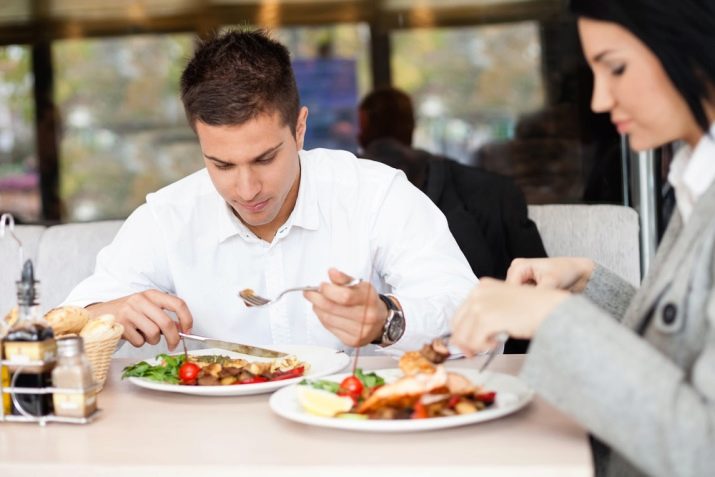
If the dish is very hot, you should wait until it cools down. No need to blow loudly on a dish or spoon, otherwise it may show a man’s bad manners. This is especially true for girls and schoolchildren.
There are a number of simple rules by following which you can learn the correct behavior during the meal:
- The distance from the body to the edge of the table should be such that the person sitting does not feel any inconvenience.
- Do not place your elbows on the table, or personal items, such as a wallet, keys or cosmetic bag. This is considered bad form.
- Do not reach for food across the table. Just ask the person nearby to give you the necessary plate or salt shaker, and then politely thank you for your help.
- To keep clothes clean, you can use a special textile napkin, which is placed on your knees before the start of the meal. Small children are allowed to fill the collar with a napkin.
- Products from common dishes should be taken with devices intended for this. The only exceptions are sugar, cookies and fruits.



Often lunch or dinner is held in the restaurant. For this case, there are special recommendations for etiquette:
- The man misses the companion first. He must open the door for her, take the outer clothing, and slide the chair. If the company consists of both women and men, then the meeting takes on a more informal character.
- In the event that several people are going to, those who are delayed wait no more than 15 minutes. Further, the meal begins regardless of whether the latecomers arrived or not. The detainee himself apologizes to all the participants in the dinner and joins the meal. In this case, it is not necessary to attract the attention of everyone sitting at the table and try to explain the reason for being late.
- With the participation of men and women in the dinner, the choice of the menu and the order of dishes usually falls on the shoulders of the stronger sex. He can offer his companion certain dishes and order them if he receives consent.
- It is considered good form to start eating only when the dishes are brought to everyone present at the table. At the same time, those who are waiting can offer others to start a meal even when their dishes are not yet ready.
- Do not defiantly examine and smell the dishes, carefully consider each ingredient and comment on the composition. It looks indecent.
- The bones should be gently spat out on a fork or spoon and placed on the edge of the plate.



No one is safe from embarrassing situations. For example, if the appliances fell to the floor, you can ask the waiter to bring a clean set. If an object accidentally crashes, do not raise a panic. Usually in such cases, the value of the damaged property is added to the account.
Etiquette forbids doing the following things in a restaurant:
- Carry out hygiene procedures while sitting at the table. Combing hair, adjusting makeup, wiping your face or neck with napkins is recommended in the restroom. It is also not accepted to leave traces of cosmetics on the dishes. It is better to blot your lips with a napkin before the meal to avoid the appearance of lipstick marks on the glass.
- Noisy blowing on a dish or drink. It is recommended to wait for cooling, and then proceed to eating.
- Loudly call service personnel, knock on a glass or click your fingers. It looks extremely uncivilized.
- Take food from a common plate with your personal cutlery. To do this, serve common serving forks and spoons.



Table etiquette is very important. Knowing all its basic tenets, you can make a good impression on others.
Rules of conduct for children at the table
As noted earlier, children should be accustomed to etiquette from an early age. Children quickly learn new information, and the learning process is easy to turn into a game. First of all, the child needs to be taught to wash his hands before each meal. First, parents themselves set an example and help the baby, and then this action will be fixed on the machine.

The child should be planted at a common table with all adults, so that he gets used to the company. There are special high chairs that will allow the baby to sit on a par with adults and feel like a full member of the family. During lunch, it is not recommended to turn on the TV, which will distract from the process of absorption of food.

A textile napkin can be tucked behind the collar. It will prevent bits of food and drink from getting on your clothes. For young children, special plastic forks and knives were invented. They do not have sharp blades and teeth, so the child will not injure himself, and the bright colors will attract interest.
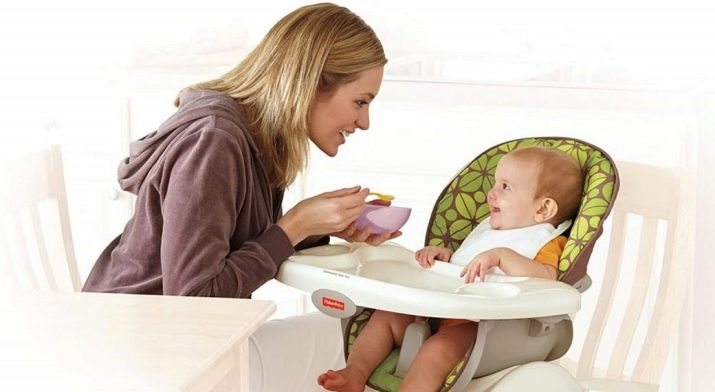
You should sit at a table straight, you can’t swing on a chair and disturb others at the table. Screams and loud conversations are unacceptable.
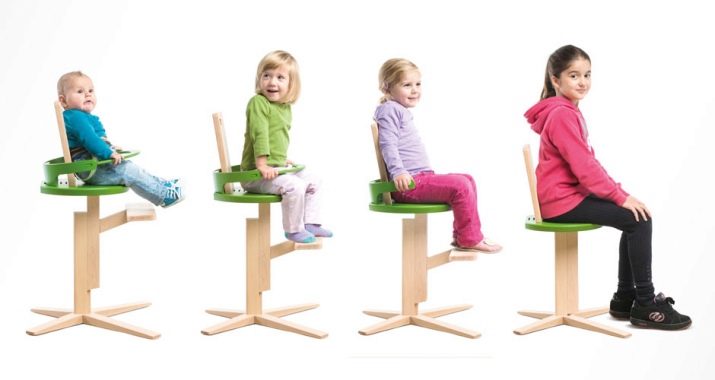
An important point in the process of teaching a child good manners at the table is the ban on playing with food. You need to explain to the children that this behavior is unacceptable, and you can not spread food on the table.
After eating, you need to thank the hostess for a delicious dinner and ask permission to leave the table. One way to teach your child the proper serving is to involve him in the process of setting the table. Let the baby help arrange the dishes and lay out the cutlery.

The most important thing is to be patient and not raise your voice. Perhaps the baby will not understand the rules unusual for him the first time, but do not give up and get nervous. The example of other family members will help the child adapt faster and behave correctly.
Features in different countries
The rules of behavior at the table in different countries of the world are somewhat different from the usual for us. Some moments can be quite unusual and exotic for Russia. We learn what tourists should pay attention to in order to avoid uncomfortable situations:
- In Japan and Korea, as you know, eat with the help of special chopsticks. During the meal, they are supposed to be placed parallel to the edge of the table or on special supports. But sticking sticks into rice is categorically not recommended, as this is a symbol of the funeral.
- On the table in Brazilian institutions catering is a special token painted in green and red on both sides. The green side says that the visitor wants to be brought more food. And it often happens that the waiter brings new dishes almost without a break. To limit the hospitality of the staff, turn the badge on the red side.
- Georgia famous for its wine. It is not surprising that this drink accompanies almost every meal. Tourists should remember that during a feast it is customary to drink wine completely after each utterance.
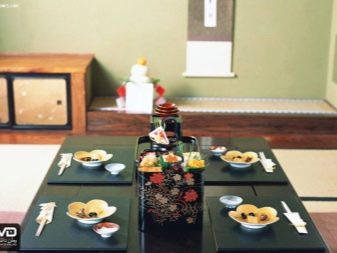
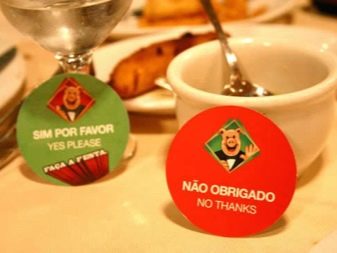
- In India and England it is not recommended to eat with the left hand, since in the traditional Indian religion this hand is considered unclean. This rule also applies to handshakes and transmission of documents.
- Coffee lovers should be careful in Italy since in this country it is not customary to drink cappuccino in the afternoon. Locals believe that this can have a bad effect on digestion. Another interesting fact: in Italy, do not add parmesan to pizza or pasta. French etiquette is somewhat similar to Italian.
- Tourists Traveling in China, restaurants often order fish. With this choice of dish, you should remember that you can not turn the portion. This is a bad omen, which means a high probability of a wreck of a fisherman's boat. After eating the upper half of the portion, it would be better to first remove the ridge from the fish and only then continue the meal.



Before traveling to any country, you should first of all familiarize yourself with the basic accepted etiquette rules. We must respect the culture of others and try to avoid uncomfortable situations that can offend local residents.
Table setting
The table should always be properly served, regardless of whether it is a business lunch or a family dinner. It accustoms to the culture and gives the meal a solemn mood. At the sight of neatly placed plates and cutlery, adhering to the recommendations for behavior at the table is much easier.


There are a huge number of table setting methods that depend on the time of day, the nature of the event and many other factors.
For the classic table setting, which is suitable for any occasion, you can use the following rules:
- A tablecloth must be present on the table. This will give even the most ordinary meal a festive and solemn mood. It is better if the tablecloth is a light shade. Dishes on such a canvas will look stylish. According to the rules, the tablecloth should hang no more than 30 cm from the edge of the table.
- The chairs should be placed with a certain interval between them, so that the diners would be comfortable sitting and not hitting the neighbors with their elbows.
- At a distance of about 2-3 cm from the edge, a serving plate is placed, which serves as a stand for everything else. Put a deeper dish on top. Plates for bread and pies are located on the left. Soups and broths are served in a special soup plate or bowl.
- Cutlery is placed on napkins made from cellulose. They are picked up in the tone of the tablecloth. Cloth napkins for protection of clothes are laid on a plate in a folded form.
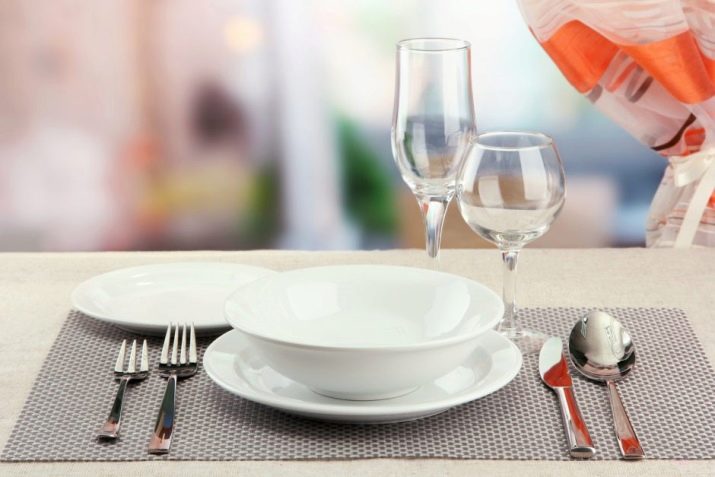
- To the right of the plate are those devices that are held, respectively, in the right hand. A tablespoon is laid so that the convex side is on the bottom. The knife should lie with the cutting side towards the plate. The teeth of the fork should look up. A dessert spoon is placed on top of the plates.
- Some people prefer to drink water while eating, so it’s good to put a glass of clean drinking water in front of a knife. In addition to water, in a glass there can also be juice, compote or other soft drinks.
- Plates with common dishes are placed in the center of the table. They are supposed to put cutlery for general use.
- Hot drinks are served in a special coffee pot, and cups are immediately put on the table.A small saucer should be placed under the cup, and a teaspoon next to it.
- Sugar is poured into a sugar bowl. A serving spoon is served with it. Currently, sugar bowls with a dispenser are often used.
- All dishes should be perfectly clean, without chips and cracks.
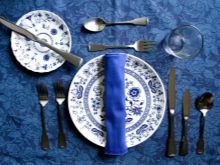
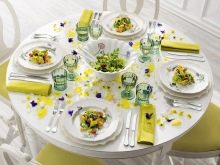
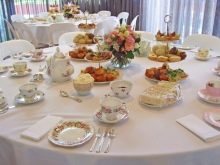
Vases with fresh flowers placed in the center of the table also look very beautiful. They will become an additional decoration and give the table a festive look.
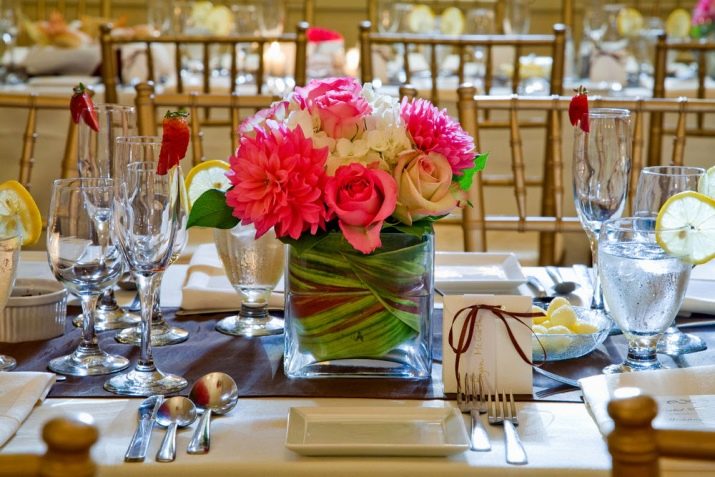
How to use devices?
The person who first came to the restaurant can get confused in a large number of different cutlery. The following rule will allow you to feel more confident: devices lying on the left side of the plate are held only in the left hand. Usually these are forks of different sizes. A similar rule applies to cutlery on the right - it can be spoons and table knives.
As an exception, you can take a fork in your right hand if there is a loose side dish on the plate: rice, buckwheat, mashed potatoes. In other cases, a table knife can help pick up food on a fork.



Sometimes serving includes the presence of several forks and knives. In order not to get confused, it is possible to gradually replace the cutlery during the change of dishes, starting from those farthest from the plate and ending with neighbors.
In particularly difficult cases, it is recommended to see how other people sitting at the table will handle the devices and take an example from them.
You can remember the following combinations of dishes and cutlery intended for them:
- dessert is eaten with a teaspoon or a special dessert spoon;
- tablespoons are for soups and broths;
- a fork in combination with a table knife is used for hot meat dishes;
- there is a special fish knife for fish;
- cold appetizers are usually eaten with a fork and a diner with a table knife;
- fruits are allowed to eat with your hands or with special cutlery.




Etiquette rules also determine how to properly hold cutlery in your hand:
- The spoon should be laid in the hand so that the thumb is on the top of the handle. The broth should be scooped away from you to prevent dropping on clothing. If there is soup with pieces of meat on the table, then first you are supposed to eat liquid broth, and then cut the meat with cutlery.
- It is recommended to hold the plug so that the fingers are further from the base. In this case, you can hold both teeth down and up. It depends on the type of food served.
- When using a table knife, the fork is held strictly in the left hand, and the knife is in the right. In this case, you can help yourself with your index fingers, they will more accurately direct the pressure of the device.
- The knife can be used to spread butter or paste on a piece of bread. Do not take food slices from a knife or lick a blade.
- When using a meat knife, remember that you should not cut the entire portion at once. You need to gradually cut off small pieces and eat them.
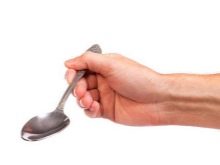
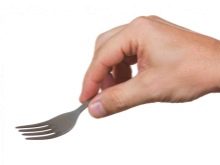
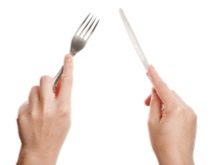
A dish with spaghetti can cause difficulties when trying to eat it carefully. But in fact it is quite simple to do. You need to place the fork in the middle of the portion, separate a small amount of spaghetti, wind it on the cutlery and immediately bring it to your mouth. This method looks neat and beautiful.
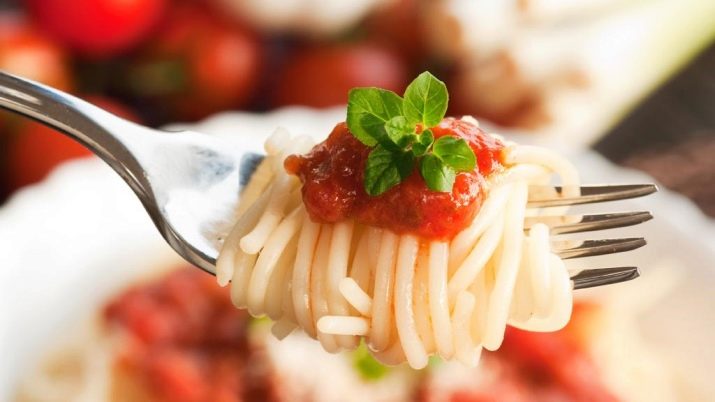
A sign of bad taste is considered to check the cleanliness of the cutlery and attract the attention of all those present. If necessary, you can politely ask the waiter to replace the fork or spoon.
At the end of lunch or dinner, cutlery should be placed on a plate parallel to it, while the handle of the knife and fork should be directed in different directions. Typically, this is a signal that you are finished with lunch or dinner, and the waiter can take the appliances away. Do not move the plate away from you, you need to leave everything in its place.

It should also be noted that while eating, the fork and knife should not be left on the table. You need to put them strictly on a plate even after eating.
Tips & Tricks
Etiquette rules apply not only to serving and the ability to eat food beautifully with cutlery, but also to the behavior itself during a feast. Regardless of where the meal takes place, at a party or in an expensive restaurant, there are a number of unwritten rules:
- before starting the meal, usually the guest waits until the food is delivered to everyone at the table;
- no need to open alcoholic drinks yourself - this should be done by the waiter or the landlord;
- You should not talk at the table with a loud voice, as this may prevent other guests from enjoying meals and relaxing;
- if lunch or dinner takes place in a restaurant, it is recommended to clink glasses as quietly as possible so as not to cause inconvenience to other visitors.
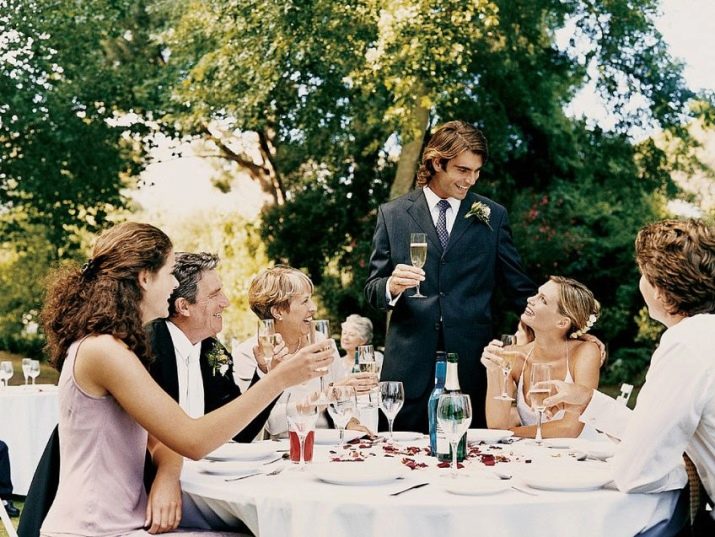
The rules of table etiquette include the manner of conducting a conversation. So, experts do not recommend discussing issues related to diseases, finances, political events and religion. When talking with one of those sitting at the table, you need to meet his eyes, listen carefully and not interrupt.
If any topics turn out to be unpleasant, you can try to transfer the conversation in another direction or politely refuse to discuss this issue. In the event of a tense dispute, it is better to defuse the situation with a funny joke or an appropriate joke.
You should not always talk to only one person, and even more so, to whisper with him. It is advisable to involve in the conversation all the participants in the meal.
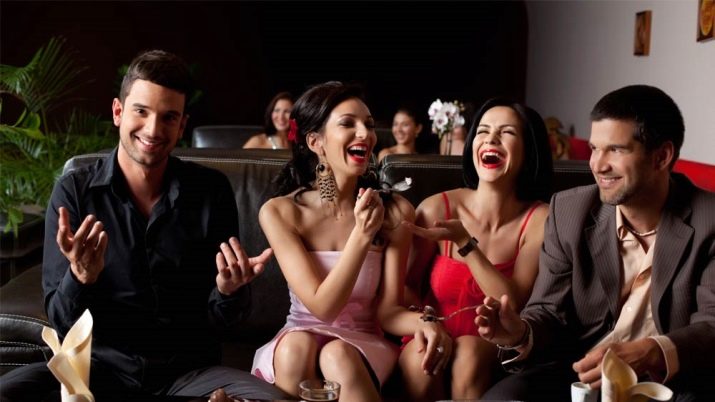
A cultural person should also heed a number of useful tips:
- When making a toast, one of the participants in the dinner should stop eating and listen to him carefully. Talk or other actions distracting from speech are not allowed.
- Gum should be wrapped in a paper napkin and carefully placed near a plate.
- When using toothpicks, you need to cover your mouth. Do not break a toothpick and scatter parts of it.
- You can take bread from a common plate with your hands. Do not bite off immediately a large piece. It is recommended to break off a small slice and only then put it in your mouth.
- You can’t eat poultry meat with your hands, and then gnaw the bones from it. Such actions look indecent.
- Cutlery is usually passed forward with the handle, and take - in the middle.
- After lunch, the knee napkin should be placed next to the plate.
- A glass of wine should be held by the leg, so as not to mess the glass, and keep the drink chilled.
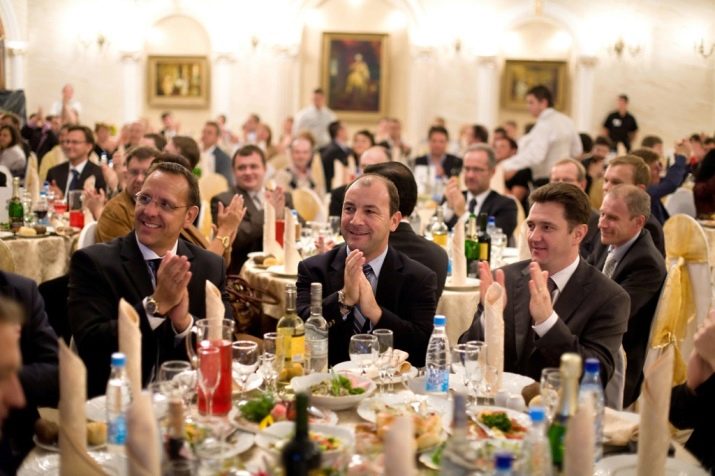
Good manners imply not noticing the flaws of others in attendance. No need to make comments out loud even to children. Do not comment on the contents of the plates of others sitting at the table, as well as the amount of alcohol in their glasses.
These simple rules will allow for a short period of time to increase overall literacy and culture, as well as to show your best side during a business or friendly dinner.
About the rules of etiquette at the table, see the next video.






